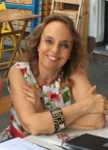
BELARDELLI Clarissa
- Roma, Regione Lazio, Istituto Italiano di Preistoria e Protostoria, Rome, Italy
- Ceramics, Europe, Protohistory
- recommender
Recommendations: 0
Review: 1
Review: 1

A database of lapidary artifacts in the Caribbean for the Ceramic Age
Open data on beads, pendants, blanks from the Ceramic Age Caribbean
Recommended by Ben Marwick based on reviews by Clarissa Belardelli, Stefano Costa, Robert Bischoff and Li-Ying WangThe paper 'A database of lapidary artifacts in the Caribbean for the Ceramic Age' by Queffelec et al. [1] presents a description of a dataset of nearly 5000 lapidary artefacts from over 100 sites. The data are dominated by beads and pendants, which are mostly made from Diorite, Turquoise, Carnelian, Amethyst, and Serpentine. The raw material data is especially valuable as many of these are not locally available on the island. This holds great potential for exchange network analysis. The data may be especially useful for investigating one of the fundamental questions of this region: whether the Cedrosan and Huecan are separate, little related developments, with different origins, or variants or a single tradition [2].
In addition to metric and technological details about the artefacts, the data include a variety of locational details, including coordinates, distance to coast, and altitude. This enables many opportunities for future spatial analysis and geostatistical modelling to understand human behaviours relating to ornament production, use, and discard. I recommend the authors make a minor revision to Table 1 (spatial coverage of the dataset) to make the column with the citations conform to the same citation style used in the rest of the text.
I warmly commend the authors for making transparency and reproducibility a priority when preparing their manuscript. Their use of the R Markdown format for writing reproducible, dynamic documents [3] is highly impressive. This is an excellent example for others in the international archaeological science community to follow. The paper is especially useful for researchers who are new to R and R Markdown because of the elegant and accessible way the authors document their research here.
[1] Queffelec, A., Fouéré, P. and Caverne, J.-B. 2021. A database of lapidary artifacts in the Caribbean for the Ceramic Age. SocArXiv, 7dq3b, ver. 4 Peer-reviewed and recommended by PCI Archaeology. https://doi.org/10.31235/osf.io/7dq3b
[2] Reed, J. A. and Petersen, J. B. 2001. A comparison of Huecan and Cedrosan Saladoid ceramics at the Trants site, Montserrat. In Proceedings of the XVIIIth International Congress for Caribbean Archaeology (pp. 253-267).
[3] Marwick, B. 2017. Computational Reproducibility in Archaeological Research: Basic Principles and a Case Study of Their Implementation. Journal of Archaeological Method and Theory 24, 424–450. https://doi.org/10.1007/s10816-015-9272-9